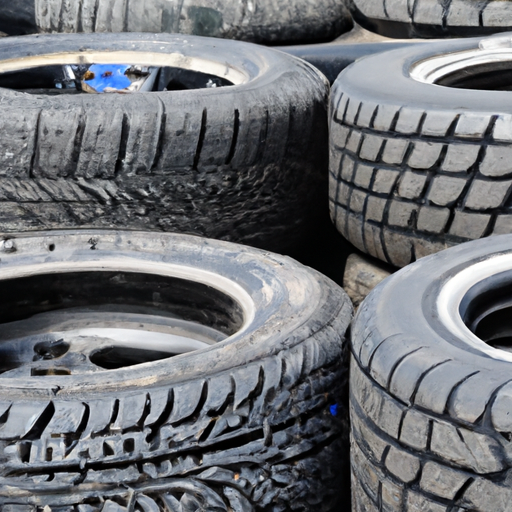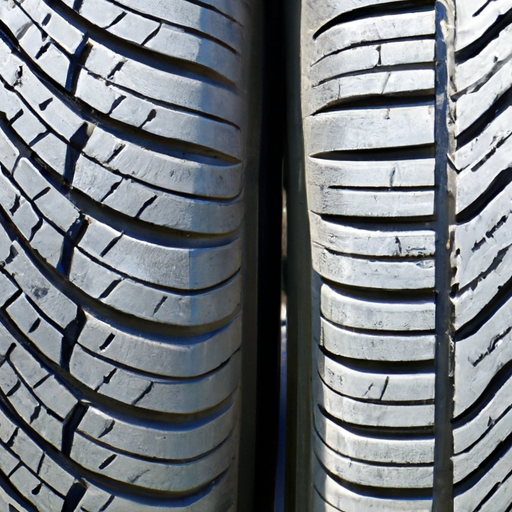If you’re considering switching to summer tires for the warmer months, it’s important to understand any potential limitations or drawbacks that come with them. While summer tires offer enhanced performance in dry and warm conditions, they may not be suitable for all weather conditions or road surfaces. This article will explore the possible limitations and drawbacks of using summer tires, helping you make an informed decision for your driving needs.

Limited Traction in Cold Temperatures
Reduced grip on icy and snowy roads
Summer tires are specifically designed to perform optimally in warm or hot weather conditions. As a result, they tend to lose their grip when the temperature drops below 45 degrees Fahrenheit (7 degrees Celsius). This reduced grip can be particularly problematic on icy and snowy roads, where traction is crucial for maintaining control of your vehicle. It’s important to keep in mind that summer tires are not equipped with the necessary tread patterns and rubber compounds to provide the necessary traction on slippery winter surfaces.
Longer braking distances in winter conditions
Due to their reduced traction on icy and snowy surfaces, summer tires also require longer braking distances in winter conditions. When you apply the brakes, the tires need sufficient grip to effectively stop the vehicle. However, in cold weather, summer tires struggle to generate enough traction, resulting in longer stopping distances. This can increase the risk of accidents, especially in emergency situations where a quick stop is necessary. It’s crucial to recognize the limitations of summer tires and consider alternative options for improved safety and performance in colder climates.
Decreased Performance in Wet Conditions
Increased risk of hydroplaning
Summer tires are designed to excel in dry conditions, but their performance diminishes significantly when faced with wet surfaces. The tread pattern of summer tires is optimized for dry roads, with wider and shallower grooves that do not effectively evacuate water. As a result, these tires are more prone to hydroplaning, where a layer of water builds up between the tires and the road, leading to a loss of control. It’s crucial to exercise caution when driving with summer tires in wet conditions, as they can compromise your ability to navigate safely on slippery surfaces.
Reduced grip on wet roads
In addition to the increased risk of hydroplaning, summer tires also offer reduced grip on wet roads. This is due to the shallower grooves and the firm rubber compound found in these tires, which are optimized for dry traction. When the road is wet, the tires struggle to maintain a strong connection with the surface, resulting in reduced grip and compromised handling. This can diminish your ability to navigate corners and make sudden maneuvers, posing a safety risk. It’s essential to consider alternative tire options that provide better performance in wet conditions, particularly if you frequently encounter rain or wet roads.
Not Suitable for All-Season Use
Inadequate performance in winter
Summer tires are specifically designed for warm weather conditions and are not suitable for use during the winter season. With limited traction on snowy and icy surfaces, these tires can compromise your safety and control on the road. When temperatures drop, the rubber compound of summer tires hardens, further reducing their ability to grip the road. It’s vital to switch to winter or all-season tires when temperatures start to decrease to ensure optimal performance and maximized safety.
Limited traction in spring and fall
While summer tires may offer satisfactory performance in spring and fall when temperatures are milder, they still exhibit limited traction compared to all-season tires. Spring and fall seasons are characterized by unpredictable weather conditions, including rain showers and occasional temperature drops. All-season tires are better equipped to handle these changing conditions, providing improved grip and stability. By using summer tires outside of their recommended temperature range, you risk compromising your safety and the overall performance of your vehicle.
Shorter Lifespan
Faster tread wear
Summer tires typically have a shorter lifespan due to their design and specialized rubber compound. The tread pattern of summer tires prioritizes dry traction, resulting in increased friction and faster wear on the tire’s surface. This means that the tires will need replacement more frequently, leading to higher maintenance costs in the long run. Additionally, the nature of summer driving conditions, with their higher temperatures and potentially more aggressive driving habits, can also contribute to accelerated tread wear and decreased tire life.
Reduced durability on abrasive surfaces
Summer tires are not designed to withstand the wear and tear caused by driving on abrasive surfaces, such as gravel or rough roads. The softer rubber compound used in the construction of summer tires prioritizes grip and performance on smooth, paved roads. When driven on rough surfaces, the tires can experience accelerated wear and reduced durability. This can result in premature tire failure, compromising your safety and requiring more frequent replacements. It’s important to assess your driving habits and road conditions to determine if summer tires are the best choice for you.

Increased Noise and Vibration
Louder road noise compared to all-season tires
Summer tires, with their specialized tread patterns and rubber compounds, tend to produce more road noise compared to all-season tires. This increased noise can be noticeable, especially on highways or rougher road surfaces. The larger tread blocks and shallower grooves of summer tires contribute to the higher noise levels. While noise alone may not be a significant concern for many drivers, it can affect the overall comfort and enjoyment of the driving experience.
Vibration at high speeds
Another drawback of summer tires is the potential for increased vibrations, particularly at higher speeds. The design of these tires, optimized for dry road performance, can lead to a less smooth and comfortable ride. The vibration may be felt through the steering wheel or the vehicle itself, affecting the overall driving experience. If you prioritize a smooth and quiet ride, it may be worth considering alternative tire options that offer better comfort and minimize vibrations.
Reduced Fuel Efficiency
Higher rolling resistance
Summer tires tend to have higher rolling resistance compared to all-season tires. Rolling resistance refers to the energy required to keep the tires rolling when the vehicle is in motion. The specialized rubber compound and tread patterns of summer tires create more friction against the road, resulting in increased resistance and higher fuel consumption. By using summer tires, you may experience a decrease in fuel efficiency, thus requiring more frequent refueling and ultimately impacting your wallet.
Increased fuel consumption
As a result of the higher rolling resistance, summer tires can also contribute to increased fuel consumption. The additional effort required to overcome the resistance leads to more work for the engine and increased fuel usage. While the difference in fuel consumption may not be significant for shorter trips or occasional use, it can accumulate over time and impact your overall fuel expenses. If fuel efficiency is an important consideration for you, all-season or fuel-efficient tires may be a more suitable choice.

Higher Cost
More expensive than all-season tires
Summer tires generally come with a higher price tag compared to all-season tires. The specialized design, rubber compounds, and manufacturing processes required to achieve optimal dry performance contribute to the increased cost. This higher upfront cost can be a deterrent for some drivers, particularly if they do not live in a region with extended periods of warm weather. It’s important to consider your driving habits, climate, and budget when deciding whether summer tires are the right investment for you.
Additional cost of seasonal tire changes
One of the limitations of using summer tires is the need for seasonal tire changes. In regions with distinct seasons, drivers with summer tires must switch to winter or all-season tires once temperatures start to drop. This transition requires additional time, effort, and potentially expenses to have the tires swapped at a tire shop. Additionally, the need for storage space to house the unused set of tires during the off-season can be a hassle for some drivers. These ongoing costs and inconveniences should be factored into your decision when considering the use of summer tires.
Limited Availability
May not be readily available in all sizes or brands
While summer tires are commonly available for many vehicles, there is still the possibility that specific sizes or brands may be less readily available. If you have an uncommon tire size or prefer a specific brand, you may encounter difficulties in sourcing the appropriate summer tires. It’s advisable to check the availability of your desired summer tires before making a final decision. Consider reaching out to local tire shops or conducting online research to ensure that the tires you want are accessible to you.
Limited availability in certain regions
The availability of summer tires can also be influenced by your geographical location. Areas with colder climates or frequent winter conditions may have limited options for summer tires due to lower demand. This can make it more challenging to find the right tire size or specific summer tire models. If you live in a region that experiences extended periods of cold weather, it’s essential to evaluate the practicality and availability of summer tires before making a purchase.

Installation and Storage Hassles
Need for two sets of tires and separate storage
Using summer tires requires having two sets of tires – one for the warm weather months and another for the colder seasons. This means you will need to invest in additional tires and arrange for their installation when the seasons change. The need for separate storage for the unused set of tires during the off-season can be a hassle, particularly for drivers with limited garage or storage space. It’s crucial to consider the logistical aspects and potential inconveniences associated with having two sets of tires before opting for summer tires.
Time and effort required for seasonal tire changes
Beyond the cost and storage considerations, using summer tires also requires additional time and effort for seasonal tire changes. When the weather transitions from warm to cold or vice versa, you will need to schedule an appointment at a tire shop to have the tires swapped. This process can be time-consuming, especially during peak seasons when tire shops are busy. It’s important to factor in the effort required for seasonal tire changes into your decision-making process, considering your schedule and availability.
Safety Concerns for Inexperienced Drivers
Less forgiving handling characteristics
Summer tires are designed to maximize performance and handling in dry conditions, but this can make them less forgiving for inexperienced drivers. The enhanced grip and responsiveness of summer tires can be challenging to manage if you are not familiar with their characteristics. Abrupt maneuvers, such as sudden steering inputs or aggressive braking, can result in loss of control or skidding. It’s crucial for less experienced drivers to be aware of the potential challenges associated with summer tires and adjust their driving habits accordingly.
Limited performance margin in emergency situations
In emergency situations on the road, having a tire that can provide optimal traction and control is critical. Summer tires have a limited performance margin in such scenarios, particularly on wet or slippery surfaces. The reduced grip and longer braking distances associated with summer tires can compromise your ability to respond promptly and effectively during emergency maneuvers. Inexperienced drivers, in particular, may find it more challenging to navigate unexpected situations with summer tires. In these cases, exploring alternative tire options that offer improved performance and safety margins may be a wise choice.
In conclusion, while summer tires excel in warm and dry conditions, they are not without limitations and drawbacks. Reduced grip and longer braking distances in cold and wet conditions, limited suitability for year-round use, shorter lifespan and reduced durability, increased noise and vibration, reduced fuel efficiency, higher cost, limited availability, installation and storage hassles, and safety concerns for inexperienced drivers are all factors to consider before opting for summer tires. It’s essential to evaluate your driving habits, local climate, and personal preferences to determine the most suitable tire choice for your needs.


